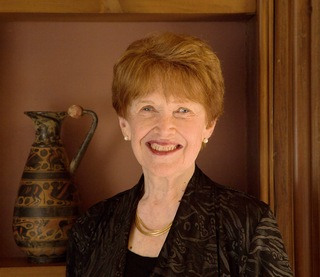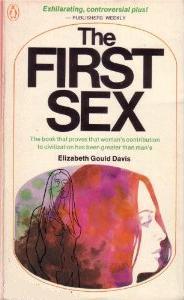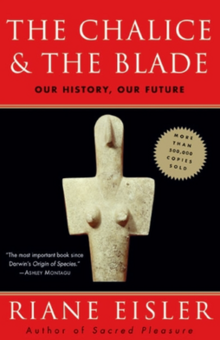
Matriarchy is a social system in which positions of dominance and authority are primarily held by women. In a broader sense it can also extend to moral authority, social privilege, and control of property. While those definitions apply in general English, definitions specific to anthropology and feminism differ in some respects. Most anthropologists hold that there are no known societies that are unambiguously matriarchal.
Dominator culture refers to a model of society where fear and force maintain rigid understandings of power and superiority within a hierarchical structure. Futurist and writer Riane Eisler first popularized this term in her book The Chalice and the Blade. In it, Eisler positions the dominator model in contrast to the partnership model, a more egalitarian structure of society founded on mutual respect among its inhabitants. In dominator culture, men rule over women, whereas partnership culture values men and women equally.

A mother goddess is a major goddess characterized as a mother or progenitor, either as an embodiment of motherhood and fertility or fulfilling the cosmological role of a creator- and/or destroyer-figure, typically associated the Earth, sky, and/or the life-giving bounties thereof in a maternal relation with humanity or other gods. When equated in this lattermost function with the earth or the natural world, such goddesses are sometimes referred to as the Mother Earth or Earth Mother, deity in various animistic or pantheistic religions. The earth goddess is archetypally the wife or feminine counterpart of the Sky Father or Father Heaven, particularly in theologies derived from the Proto-Indo-European sphere. In some polytheistic cultures, such as the Ancient Egyptian religion which narrates the cosmic egg myth, the sky is instead seen as the Heavenly Mother or Sky Mother as in Nut and Hathor, and the earth god is regarded as the male, paternal, and terrestrial partner, as in Osiris or Geb who hatched out of the maternal cosmic egg.
Old Europe is a term coined by the Lithuanian archaeologist Marija Gimbutas to describe what she perceived as a relatively homogeneous pre-Indo-European Neolithic and Copper Age culture or civilisation in Southeast Europe, centred in the Lower Danube Valley. Old Europe is also referred to in some literature as the Danube civilisation.

The Kurgan hypothesis is the most widely accepted proposal to identify the Proto-Indo-European homeland from which the Indo-European languages spread out throughout Europe and parts of Asia. It postulates that the people of a Kurgan culture in the Pontic steppe north of the Black Sea were the most likely speakers of the Proto-Indo-European language (PIE). The term is derived from the Turkic word kurgan (курга́н), meaning tumulus or burial mound.

Riane Tennenhaus Eisler is an Austrian-born American systems scientist and author who writes about the effect of gender politics historically on society. She is most known for her 1987 book The Chalice and the Blade, in which she coined the terms "partnership" and "dominator".
Androcracy is a form of government in which the government rulers are male. The males, especially fathers, have the central roles of political leadership, moral authority, and control of property. It is also sometimes called a phallocracy or andrarchy or an androcentric or phallocratic society.

The Goddess movement is a revivalistic Neopagan religious movement which includes spiritual beliefs and practices that emerged predominantly in the Western world during the 1970s. The movement grew as a reaction both against Abrahamic religions, which exclusively have gods with whom are referred by masculine grammatical articles and pronouns, and secularism. It revolves around Goddess worship and the veneration for the divine feminine, and may include a focus on women or on one or more understandings of gender or femininity.

The First Sex is a 1971 book by the American librarian Elizabeth Gould Davis, considered part of the second wave of feminism. In the book, Gould Davis aimed to show that early human society consisted of matriarchal "queendoms" based around worship of the "Great Goddess", and characterised by pacifism and democracy. Gould Davis argued that the early matriarchal societies attained a high level of civilization, which was largely wiped out as a result of the "patriarchal revolution". She asserted that patriarchy introduced a new system of society, based on property rights rather than human rights, and worshipping a stern and vengeful male deity instead of the caring and nurturing Mother Goddess.

The Globular Amphora culture (GAC, German: Kugelamphoren-Kultur ; c. 3400–2800 BC, is an archaeological culture in Central Europe. Marija Gimbutas assumed an Indo-European origin, though this is contradicted by newer genetic studies that show a connection to the earlier wave of Early European Farmers rather than to Western Steppe Herders from the Ukrainian and south-western Russian steppes.
Cultural transformation theory proposes that societies used to follow a “partnership model” of civilization but over time, it gave way to today's current “dominator model” of civilization. This theory was first proposed by Riane Eisler, a cultural scholar, in her book The Chalice and the Blade. Eisler affirms that societies exist on a partnership-domination continuum but we as a species have moved away from our former partnership orientation to a more domination orientation by uplifting masculine ideals over feminine ideals. She insists that people do not have to live in a society based on the rule of one gender class over the other. There is historical evidence that another type of society, where all individuals are equal, is possible.

The Myth of Matriarchal Prehistory: Why An Invented Past Will Not Give Women a Future is a 2000 book by Cynthia Eller that seeks to deconstruct the theory of a prehistoric matriarchy. This hypothesis, she says, developed in 19th century scholarship and was taken up by 1970s second-wave feminism following Marija Gimbutas. Eller, a retired professor of religious studies at Claremont Graduate University, argues in the book that this theory is mistaken and its continued defence is harmful to the feminist agenda.

A matriarchal religion is a religion that emphasizes a goddess or multiple goddesses as central figures of worship and spiritual authority. The term is most often used to refer to theories of prehistoric matriarchal religions that were proposed by scholars such as Johann Jakob Bachofen, Jane Ellen Harrison, and Marija Gimbutas, and later popularized by second-wave feminism. These scholars speculated that early human societies may have been organized around female deities and matrilineal social structures. In the 20th century, a movement to revive these practices resulted in the Goddess movement.
In feminist theory, kyriarchy is a social system or set of connecting social systems built around domination, oppression, and submission. The word was coined by Elisabeth Schüssler Fiorenza in 1992 to describe her theory of interconnected, interacting, and self-extending systems of domination and submission, in which a single individual might be oppressed in some relationships and privileged in others. It is an intersectional extension of the idea of patriarchy beyond gender. Kyriarchy encompasses sexism, racism, ableism, ageism, antisemitism, Islamophobia, anti-Catholicism, homophobia, transphobia, fatphobia, classism, xenophobia, economic injustice, the prison-industrial complex, colonialism, militarism, ethnocentrism, speciesism, linguicism and other forms of dominating hierarchies in which the subordination of one person or group to another is internalized and institutionalized.
Patriarchy is a social system in which positions of dominance and privilege are held by men. The term patriarchy is used both in anthropology to describe a family or clan controlled by the father or eldest male or group of males, and in feminist theory to describe a broader social structure in which men as a group dominate women and children.

Due partly to the fact that this took place before the written record of this region began, there have been a number of theories presented over the years to fill the gap of knowledge about how and why the end of the Cucuteni–Trypillia culture happened. These theories include invasions from various groups of people, a gradual cultural shift as more advanced societies settled in their region, and environmental collapse.
Feminism is one theory of the political, economic, and social equality of the sexes, even though many feminist movements and ideologies differ on exactly which claims and strategies are vital and justifiable to achieve equality.
A matrifocal family structure is one where mothers head families and fathers play a less important role in the home and in bringing up children.

The Great Mother: An Analysis of the Archetype is a book discussing mother goddesses by the psychologist Erich Neumann. The dedication reads, "To C. G. Jung friend and master in his eightieth year". Although Neumann completed the German manuscript in Israel in 1951, The Great Mother was first published in English in 1955. The work has been seen as an enduring contribution to the literature inspired by Jung, and was the first to analyze an archetype with such depth and scope.

Ecofeminism is a branch of feminism and political ecology. Ecofeminist thinkers draw on the concept of gender to analyse the relationships between humans and the natural world. The term was coined by the French writer Françoise d'Eaubonne in her book Le Féminisme ou la Mort (1974). Ecofeminist theory asserts a feminist perspective of Green politics that calls for an egalitarian, collaborative society in which there is no one dominant group. Today, there are several branches of ecofeminism, with varying approaches and analyses, including liberal ecofeminism, spiritual/cultural ecofeminism, and social/socialist ecofeminism. Interpretations of ecofeminism and how it might be applied to social thought include ecofeminist art, social justice and political philosophy, religion, contemporary feminism, and poetry.












